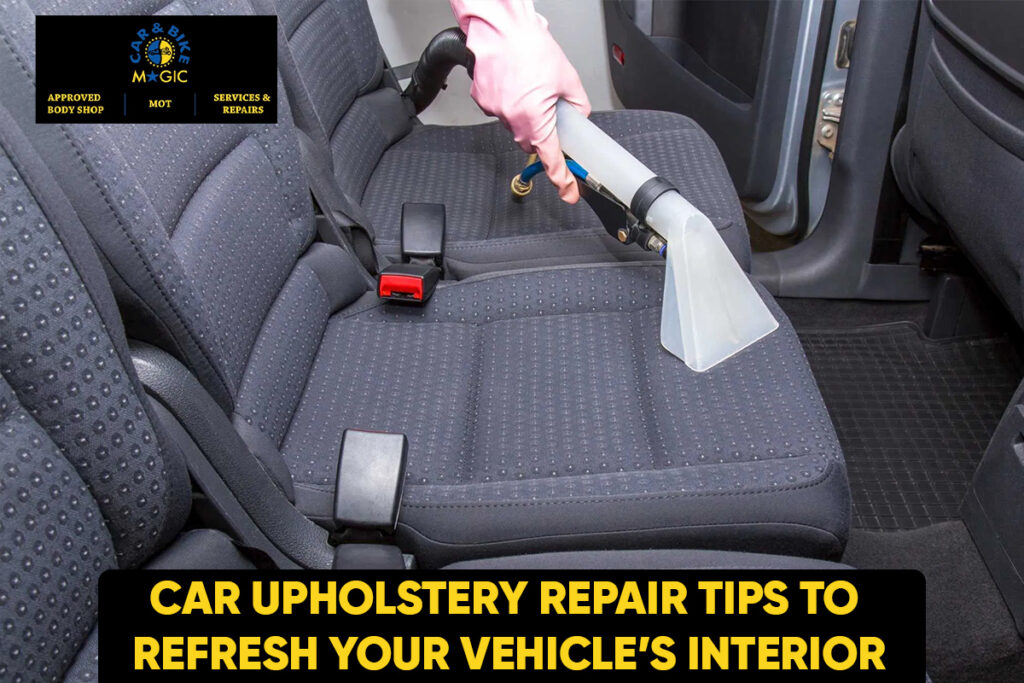When you step into your car, the first thing you notice isn’t always the engine or the dashboard—it’s the seats. A well-maintained car interior makes every drive more comfortable, while worn-out upholstery can make even a luxury ride feel outdated. Over time, daily use, sun exposure, spills, and general wear and tear can leave your seats looking tired. Fortunately, you don’t have to settle for cracks, stains, or sagging fabric. With the right car upholstery repair strategies, you can breathe new life into your vehicle’s interior without necessarily spending thousands.
Whether you want quick DIY fixes for minor issues or are considering professional car upholstery services, this guide will walk you through everything you need to know. From tackling small burns to repairing leather tears, we’ll cover practical tips to help you refresh your ride and keep it looking sharp.
Why Upholstery Repair Matters More Than You Think
Your car’s interior is more than just looks—it’s about comfort, safety, and resale value. Think about it: would you buy a used car with ripped seats and stained fabric? Probably not. That’s why auto upholstery repair is an investment that pays off in the long run.
Restoring your upholstery doesn’t just boost aesthetics; it helps protect the structure of your seats. Over time, damage like deep tears or sagging cushions can worsen if ignored, leading to higher repair costs later. Whether you’re considering leather car seat repair or a fabric car seat repair, taking action now will save you money while making your daily drives more enjoyable.
Spotting Common Upholstery Problems in Cars
Before you can fix your interior, you need to know what you’re dealing with. Here are the most common problems that drivers face:
- Tears and Rips – Small cuts in fabric or leather can expand quickly.
- Stains and Spills – Coffee, soda, and food stains are stubborn and require immediate treatment.
- Fading and Sun Damage – UV rays cause discoloration, especially in leather seats.
- Burn Marks – Cigarettes or accidental sparks can leave unsightly burns.
- Sagging Cushions – Foam inside seats can compress, making your ride uncomfortable.
Once you identify the issue, you can decide if a quick DIY fix will work or if it’s time to call a car upholstery shop for help.
DIY Upholstery Repair Tips Every Car Owner Should Try
If your car has minor damage, you don’t always need to hire professionals right away. Some quick fixes can make a noticeable difference.
- Fabric Seat Patches – For small holes or tears in cloth seats, fabric repair kits are available at auto stores. They come with adhesives and color-matched patches that blend with your seat.
- Leather Repair Kits – If you’re dealing with scuffs or cracks, leather kits with fillers and conditioners can restore smoothness.
- Foam Replacement – For sagging cushions, consider cutting and inserting new foam to restore firmness.
- Steam Cleaning – This works wonders for deep cleaning fabric seats, removing odors, and lifting stains.
While these methods are budget-friendly, they’re not always permanent solutions. For long-lasting results, consider car seat repair services from professionals.
When to Call Professional Car Upholstery Services
Sometimes, DIY just doesn’t cut it. If you’re dealing with large tears, complex fabric patterns, or luxury leather interiors, professional help is worth every penny. Skilled technicians at a car upholstery shop use advanced tools and techniques to restore your interior to near-new condition.
Professional services include:
- Complete vehicle seat repair for fabric and leather.
- Replacing damaged panels with perfectly matched materials.
- Re-stitching seams that have come apart.
- Foam and cushion rebuilding for better comfort.
If you want to understand the value of expert repair, check out this resource: Why Invest in Professional Upholstery Repair?.
Leather Car Seat Repair: Special Care for Luxury Interiors
Leather is luxurious, but it requires extra care. Unlike fabric, leather can dry out, crack, or fade without proper maintenance.
To maintain leather seats:
- Use a quality leather conditioner every 2–3 months to prevent cracking.
- Clean spills immediately to avoid staining.
- Avoid harsh cleaners that strip natural oils.
For deep cracks or severe damage, professional car upholstery services specializing in leather restoration are the best option. Some even offer color-matching dyes that seamlessly blend repairs with your original interior. For more details, explore expert upholstery repair options.
Fabric Car Seat Repair: Affordable and Effective Solutions
Fabric seats are durable, but they’re prone to stains and burns. Luckily, they’re easier and cheaper to repair than leather.
DIY fabric repair kits can patch small holes, but for larger damage, fabric car seat repair specialists use heat-transfer methods and professional-grade adhesives. Steam cleaning and re-dyeing also help restore faded fabric.
If you’re in need of professional help, you can find reliable services here: Upholstery Repairs in Sunderland.
How to Prevent Future Upholstery Damage
Repairing is good, but preventing damage is even better. Here are some easy tips:
- Use Seat Covers – They protect original upholstery from spills and sun damage.
- Regular Cleaning – Vacuum and wipe down seats to keep dirt and debris from settling.
- Park Smart – Shade or windshield covers reduce UV exposure.
- Condition Leather – Prevents cracking and keeps seats soft.
By following these steps, you’ll extend the life of your seats and save money on car interior repair in the long run.
Final Thoughts
Your car’s interior deserves the same attention as its engine. From DIY fixes to professional car upholstery services, there are plenty of ways to restore comfort and beauty to your ride. Whether you choose a simple patch kit or hire experts for a full vehicle seat repair, the result is the same—you’ll enjoy a fresher, more stylish car interior.
Don’t wait until minor damage becomes a costly replacement. Invest in auto upholstery repair today and give your car the makeover it deserves.
Frequently Asked Questions
1. How much does car upholstery repair usually cost?
Prices vary depending on material and damage. Small repairs may cost $50–$150, while professional leather restoration can range from $200–$1,000.
2. Can I repair car upholstery myself?
Yes, small rips and stains can be fixed with DIY kits, but bigger issues require professional car upholstery services.
3. How often should I condition leather car seats?
At least every 3 months, depending on climate and usage.
4. Will repairing upholstery increase my car’s resale value?
Absolutely. A clean, damage-free interior attracts buyers and can boost value by hundreds.
5. Where can I find reliable upholstery services near me?
Start with trusted providers like Car and Bike Magic or Sunderland upholstery repairs.

